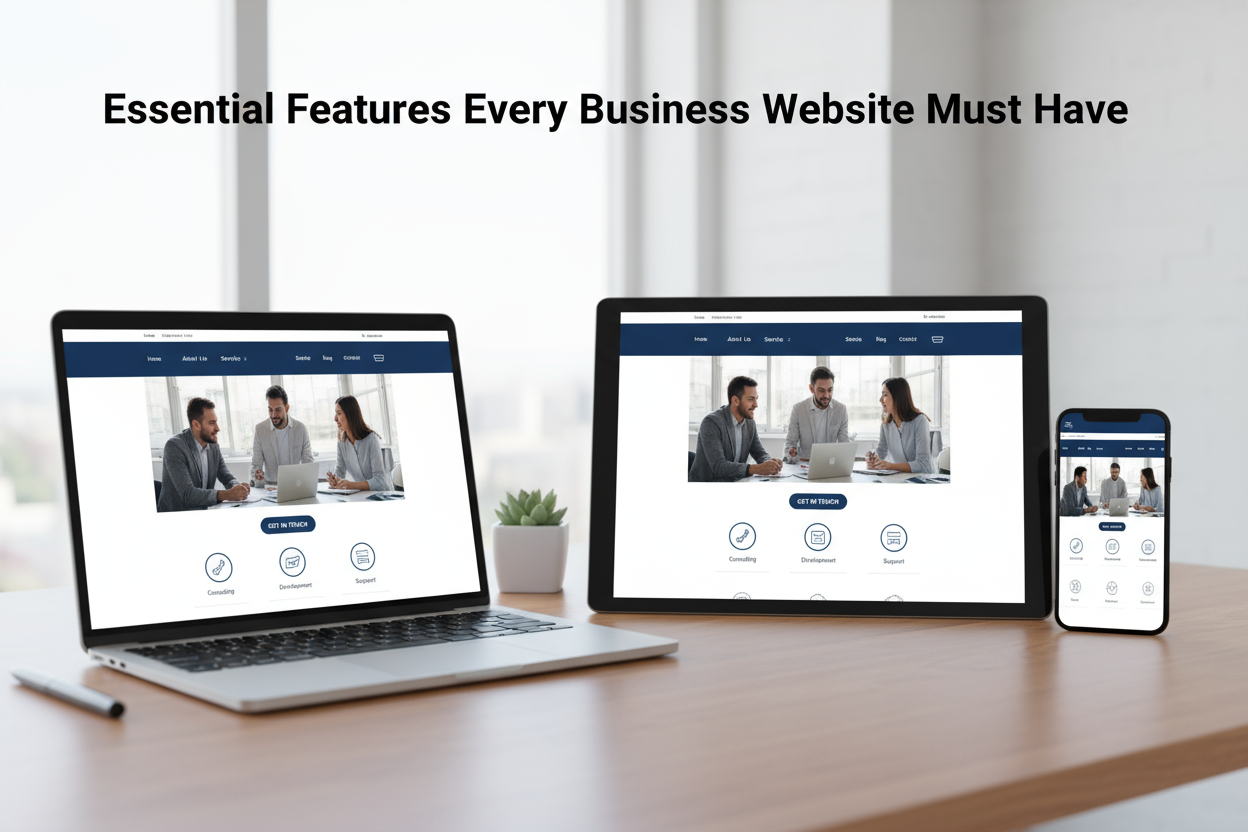In today’s competitive digital marketplace, your business website is your brand’s first impression. It’s the cornerstone of your online presence — the digital storefront where customers decide whether to engage with you or move on to a competitor. To succeed, every business website must be strategically designed, user-friendly, and optimized for performance and conversions. Below are the essential features that every successful business website must include.
1. Responsive and Mobile-Friendly Design
More than 70% of web traffic comes from mobile devices. That means your website must adapt flawlessly to any screen size. A responsive website design ensures users enjoy a smooth, consistent experience whether they’re browsing on a smartphone, tablet, or desktop.
Mobile-friendly designs should include:
- Fluid layouts and scalable images
- Easy-to-read fonts
- Clickable buttons and simple navigation
- Optimized loading for smaller screens
Google also prioritizes mobile-optimized sites in search rankings, so investing in responsiveness directly impacts your SEO performance.
2. Fast Loading Speed
Speed is one of the most critical elements of web performance. Research shows that a one-second delay in page load can reduce conversions by up to 7%. A fast website improves user satisfaction and boosts your Google ranking.
To improve loading times:
- Compress images and use next-gen formats like WebP.
- Minify CSS, JavaScript, and HTML files.
- Use caching and a reliable CDN (Content Delivery Network).
- Optimize server response times with quality hosting.
A lightning-fast website keeps visitors engaged and reduces bounce rates, directly enhancing your credibility.
3. Clear and Engaging Homepage
Your homepage is your digital handshake — it should instantly communicate who you are, what you do, and why visitors should trust you.
An effective homepage includes:
- A strong headline highlighting your value proposition
- Concise, benefit-driven content
- High-quality visuals representing your brand identity
- Prominent calls-to-action (CTAs) such as “Contact Us” or “Get Started”
Keep your design clean and professional. Visitors should understand your offerings within seconds of landing on your homepage.
4. Secure (HTTPS) and Reliable Hosting
A secure website builds trust. HTTPS encryption (enabled through an SSL certificate) protects sensitive user data and boosts your credibility. Visitors and search engines alike avoid unsecured (HTTP) websites.
Additionally, choose a reliable web host offering:
- 99.9% uptime guarantee
- Regular data backups
- DDoS protection
- Fast server response
Website security is not optional — it’s a foundation of user confidence and SEO success.
5. Intuitive Navigation
Visitors should never struggle to find information. Simple, intuitive navigation helps users explore your site easily while guiding them toward conversions.
A well-structured navigation system includes:
- A clear menu bar with logical categories
- Breadcrumbs for easy backtracking
- A visible search bar
- Internal linking between related pages
When users can quickly locate what they need, they stay longer and are more likely to engage.
6. SEO Optimization
Even the most beautiful website won’t succeed if no one finds it. That’s where SEO (Search Engine Optimization) comes in.
Your website should be optimized with:
- Targeted keywords in titles, meta tags, and content
- SEO-friendly URLs (short, descriptive, keyword-rich)
- Alt text for all images
- Regularly updated, high-quality content
- Proper heading structure (H1, H2, H3)
Integrating on-page and technical SEO ensures your website ranks higher in search results, attracting qualified organic traffic.
7. Clear Calls-to-Action (CTAs)
A call-to-action transforms visitors into customers. Every page should include clear, action-oriented CTAs that guide users to the next step — whether that’s making a purchase, booking an appointment, or signing up for a newsletter.
Best practices for CTAs:
- Use strong verbs like “Get Started,” “Buy Now,” or “Contact Us”
- Make buttons stand out with contrasting colors
- Place CTAs strategically throughout your website
When done right, CTAs boost engagement and increase conversion rates significantly.
8. Testimonials and Reviews
Trust is everything in business. Including customer testimonials, case studies, and reviews provides social proof that validates your brand’s credibility.
To maximize impact:
- Feature authentic client names, photos, or video reviews
- Display testimonials on your homepage or dedicated review page
- Encourage satisfied customers to leave Google or Yelp reviews
Testimonials build emotional confidence — the key factor in turning prospects into paying customers.
9. Contact Information and Live Chat
Make it easy for visitors to connect with you. Display your contact information — phone number, email, and physical address — prominently on every page, especially in headers and footers.
Adding live chat support can elevate user experience further by providing real-time assistance. Live chat increases conversions and demonstrates that your brand values customer service.
10. Analytics and Tracking Tools
A professional website should not only look great but also deliver measurable results. Integrate analytics tools to monitor performance and user behavior.
Recommended tools include:
- Google Analytics 4 (GA4) for traffic and engagement insights
- Google Search Console for monitoring keyword rankings and site errors
- Heatmaps (like Hotjar) to understand user interaction patterns
By analyzing this data, you can continuously refine your website and marketing strategies for better ROI.
11. Legal Pages and Privacy Policy
Every credible website must include legal pages to protect both your business and users. These should cover:
- Privacy Policy – how you handle personal data
- Terms and Conditions – rules for using your site
- Disclaimer – limits your legal liability
Including these pages not only builds trust but also ensures compliance with global privacy regulations like GDPR.
12. Social Media Integration
Integrate your social media profiles with your website to strengthen your brand presence and increase engagement. Add social icons in headers or footers and share buttons on blog posts.
This makes it easier for visitors to connect with you across platforms, boosting your reach and visibility.
Conclusion
A business website is far more than an online brochure — it’s the digital heart of your brand. By incorporating essential features like responsive design, fast loading speed, SEO optimization, and strong CTAs, you create a platform that not only attracts visitors but converts them into loyal customers.
In a world where first impressions matter, investing in a high-performing website ensures your business stands out, builds credibility, and grows consistently.







